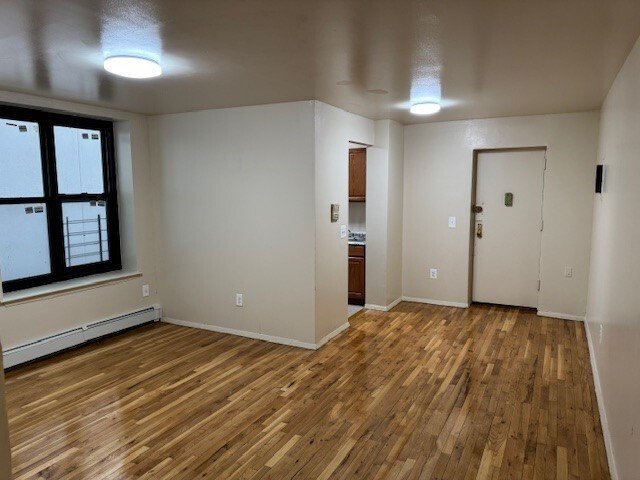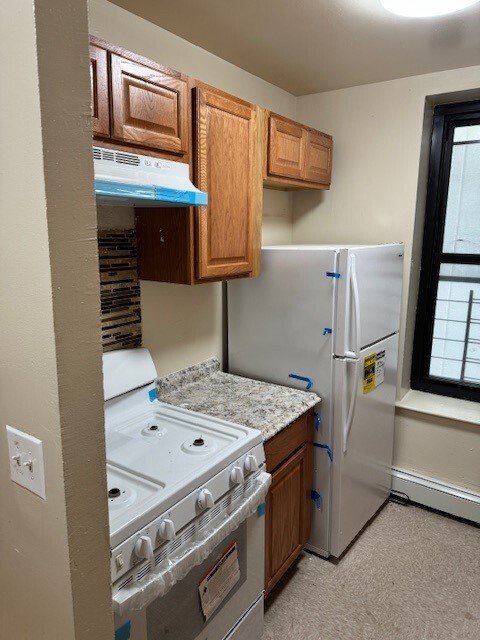A $1,250 2 bedroom in NYC? Here’s why it’s been empty for 16 months.
Feb. 10, 2025, 6 a.m.
A new report reveals the bureaucratic rules that landlords say are forcing them to hold affordable apartments empty.

The two-bedroom apartment on Tiebout Avenue in the Bronx boasts a remodeled kitchen, polished hardwood floors, new plumbing and new electrical systems. It’s a fourth-floor walkup, but the monthly rent is just $1,250.85, and the unit is reserved for families earning no more than $101,000 a year.
Yet, the renovated apartment has been sitting empty since September 2023. The owner, a nonprofit development corporation called University Neighborhood Housing Program, is desperate to rent it to a family, but its leaders say the city’s bureaucratic rules have kept them from doing that for nearly a year-and-a-half.
“It’s infuriating,” said Brendan Mitchell, University Neighborhood Housing Program’s director of real estate. “It goes against everything we believe in to have vacant units sitting there throughout a housing crisis while people we are serving are just dying to get into an apartment in the neighborhood.”
A new report from the New York Housing Conference found that hundreds, if not thousands, of similar apartments sit empty for months after tenants leave. That’s because of city rules that require landlords to sift through long lists of people registered in the city’s housing lottery system, instead of permitting owners to list them on the market or allowing would-be renters to apply directly, according to the report. Its authors say the delays are exacerbating the city's already severe housing shortage, and are calling for changes to move tenants into empty affordable apartments faster.
“New Yorkers are desperate for affordable housing and we have affordable housing units that are not being rented today because they are getting delayed by the city’s re-rental rules,” said Rachel Fee, who is the New York Housing Conference's executive director and a former official at the city’s housing agency.
It’s unclear how many vacant apartments are held up in the process citywide. The rules that require landlords to contact potential tenants were intended to make the process for filling empty affordable apartments more equitable. Fee said they apply to tens of thousands of apartments owned by private companies and nonprofit groups that qualify for tax breaks or loans from the city in exchange for pricing the units for low- and middle-income renters. The wait times are longest for older apartments that are renovated and kept affordable after the owners receive funds and tax breaks from the city, according to the report.

Mitchell, whose organization manages a portfolio of about 1,500 affordable apartments in the Bronx, said most of the people his staff contacts on the housing lottery list when an opening becomes available have no interest in the apartment, the Bronx neighborhood, or even in moving at all. He said his organization has 10 affordable apartments, including the one on Tiebout Avenue, that have been vacant for months because of the requirements.
Housing experts said it’s a prime example of a lingering problem. The 108-year-old building where the apartment is located was recently renovated by University Neighborhood Housing Program, which preserves affordable housing and provides social services in the Northwest Bronx.
After an apartment enters the affordable housing program and the initial tenant moves out, it’s classified as a “re-rental” and the unit must go to another applicant in the city’s Housing Connect lottery system. New Yorkers typically use the system to apply for a spot in brand-new high rises in Greenpoint, East New York, East Harlem and many other parts of the city. In the case of a “re-rental,” however, city rules require many owners to select a new tenant from a pool of existing housing lottery applicants who indicated that they were open to re-rental opportunities. The owner receives a batch of up to 250 applicants and then must contact each one, giving them 10 days to respond until finding someone willing to move in, the New York Housing Conference report found.
That process may go more quickly for a newer building that was previously posted on Housing Connect, but not so for older buildings, like the century-old properties that University Neighborhood Housing Program operates. One property manager contacted about 1,000 applicants from the randomly selected pool but only received 20 responses, according to the report.
”It’s almost false advertising because when we do get [someone] who is willing to move, and they go look at it they're disappointed because those are not the buildings that they're seeing on the housing lottery,” Mitchell said.
Ilana Maier, a spokesperson for the city’s Department of Housing Preservation and Development, said the agency is working on improving the process for filling vacant apartments.
“Our mission is to connect New Yorkers to housing equitably and efficiently in every neighborhood,” Maier said. “We recognize that there is always more to be done and continue to engage with the residents, owners, and industry partners to strengthen our processes.”
She said vacant affordable units take an average of 44 days to fill after property owners sort through applicants. The New York Housing Conference report, however, found that process can take several months.
While the city did allow University Neighborhood Housing Program to post the building on the housing lottery in September 2023, the organization said that still hasn’t allowed it to find tenants.
By contrast, people who know the area and find out about the empty apartment — and its price — are eager to move in, Mitchell said.
“When we do get a vacancy in a place like this, word gets around and we constantly have people showing up with applications every single day,” Mitchell said. “People really want this apartment. We’re just not getting connected to them through the lottery.”
The Department of Housing Preservation and Development said it has made some accommodations, like allowing property owners to market buildings on Housing Connect if four or more apartments in a single building become vacant at the same time. Landlords can also apply for a waiver to market a unit outside the lottery system after contacting at least 250 applicants.
Previous policy debates around vacant apartments have tended to focus on “warehousing,” in which landlords hold thousands of rent-stabilized apartments off the market because they claim the rents they’re allowed to charge aren’t enough to offset renovations and other costs. Apartments classified as “affordable” are different from those labeled rent-stabilized because they are subsidized by the city and tenants must meet certain income levels.
Fee, from New York Housing Conference, said the city could easily lift the barriers that keep those affordable units empty. The organization’s report recommends a rule change that would exempt vacant apartments from the lottery system. That might allow New Yorkers who meet income criteria to directly apply for an apartment through a property management office or broker when it becomes available. This would only apply to existing apartments that become empty after a tenant leaves, not for newly constructed buildings. Short of that, the report recommends that the city promptly post the vacant units on Housing Connect so potential renters know what they are applying for.
“We need a system that’s more efficient,” Fee said. “The city does this in the name of fair housing, but has created a system of random selection with applicants who haven’t expressed interest in those apartments.”
The affordable apartments affected by the rules are among the most in-demand in the five boroughs, according to city data. The most recent survey from the Department of Housing Preservation and Development found that less than 1% of apartments priced below $1,650 were vacant. For apartments priced below $1,100, the vacancy rate was less than 0.4%.
The report describes two other University Neighborhood Housing Program apartments that have remained empty for months. A one-bedroom on Crotona Parkway priced at $1,043 a month has been available since June 2024. Tenants finally moved into a two-bedroom on East 180th Street priced at $966 a month on Jan. 1, after seven vacant months.
The delays at the three apartments have cost the organization more than $36,000 in missing rent payments.
“Time and money are wasted by owners trying to find a match for their vacant unit among a pool of applicants who often never intended to apply,” the report states.
It’s the latest attempt to streamline the affordable housing lottery process. A 2021 analysis by the Citizens Housing & Planning Council urged the city to simplify the eligibility process and track wait times after finding it took more than a year for new building owners to lease all the affordable apartments through the lottery.
The Citizens Housing & Planning Council's Executive Director Howard Slatkin said he supports the report’s findings.
“Every day a unit sits vacant, that’s someone who’s not housed and an affordable housing operator who can’t collect rent,” Slatkin said.
‘Distressing’ number of NYC adults found ineligible for emergency services, despite rise in referrals NYC housing officials blame late Section 8 rent payments on federal disarray New legislation would speed repairs for fire victims by making NYC landlords pay their rents